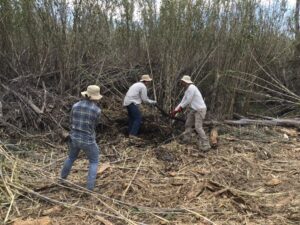Invasive plant species removal program being developed to improve flows in Santa Clara River

SCCWRP has begun working with Santa Clara River watershed managers to develop a pilot management program for removing an invasive plant species that uses up to six times as much water as native vegetation – an effort that could offer a nature-based solution for restoring more natural flow patterns to the urbanized watershed.
The SCCWRP-facilitated group, convened in August, is designing a program for removing the invasive Arundo donax (giant reed), then implementing ongoing monitoring and deciding how to mobilize rapidly to combat its regrowth.
This management solution stands in contrast to traditional engineered approaches for achieving environmental flow objectives, such as managing storage volumes, diversion rates and discharge patterns – all modifications that can have unintended environmental and societal consequences. Nature-based solutions, which are designed to closely mimic natural processes, tend to have less harmful environmental effects while providing co-benefits for both humans and wildlife.
An initial draft of the management plan is expected in late 2026.
In a related effort, SCCWRP and its partners also are exploring how to use nature-based solutions to optimally mitigate increased Southern California water temperatures at stream sites where treated wastewater effluent is being discharged, including in the Santa Clara River watershed.
More news related to: Ecohydrology